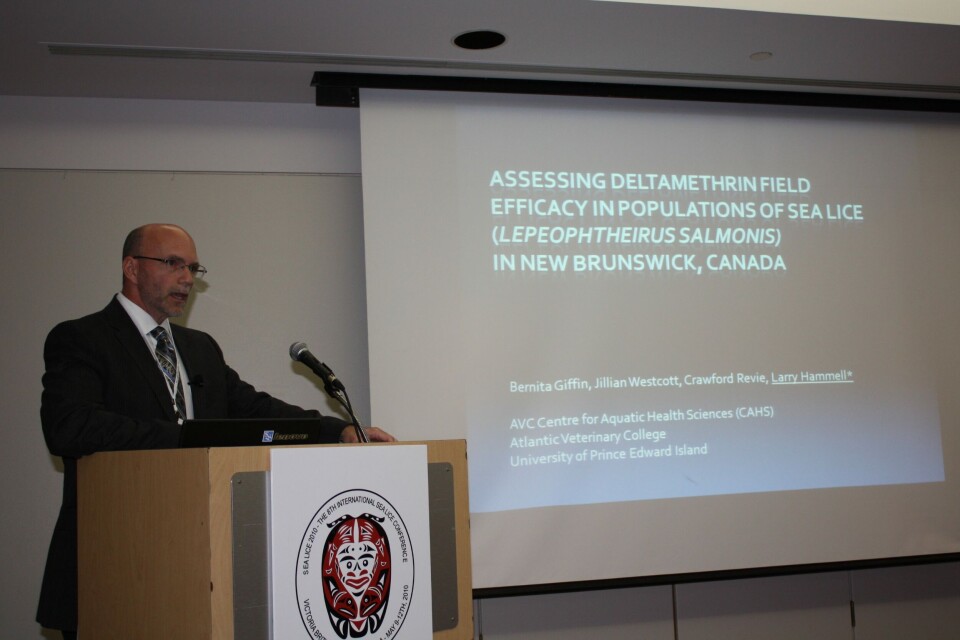
New Brunswick fish farmers fighting sea lice
At least nine out of ten treatments of farmed Atlantic salmon carried out in British Columbia are done for political reasons and not for the protection of the well-being of the fish. Very seldom does the farmed salmon here have enough sea lice on it to justify spending hundreds of thousands of dollars on the one and only treatment available to farmers. Although it hasn’t been seen yet, the frequent use of SLICE™ for the politically motivated and envisioned protection of wild salmon is causing concerns about the possibility of lice developing resistance to Emamectin benzoate, the active ingredient in SLICE™. On the eastern seaboard of Canada, the situation is totally different, with the Atlantic version of the Lepeophtheirus salmonis sea lice in some cases causing serious harm to farmed stocks, and where in New Brunswick, resistance to this treatment has already caused farmers and scientists to look for alternative treatments, as Derwin Gowan of The Telegraph Journal writes;
Last year, this bane to New Brunswick's salmon aquaculture (sea lice) showed resistance to emamectin benzoate, sold as SLICE, the industry's silver bullet since in 2000. "SLICE was super-effective and no other product was coming into the market," said Hammell, director of the Centre for Aquatic Health Sciences at the Atlantic Veterinary College in Charlottetown. "We need another product." The industry needs it before the warmer water causes the sea lice to grow in floating cages in the Bay of Fundy this summer, he said.
At a closed meeting in St. George recently aquaculture representatives discussed "well-boat" treatment for sea lice. With this system, fish farmers pump salmon into a large boat with a waterproof hold or tank in which to treat the fish before returning them to their sea cages. The New Brunswick Salmon Growers' Association expects a leased well-boat to arrive in the Bay of Fundy soon. "I hope (this) week," Executive Director Pamela Parker said in an interview Friday. The salmon growers still need approval from Canada's Pest Management Regulatory Agency for the pharmaceutical products they would use in the well-boat.
Parker hopes for approval within two weeks to use the common disinfectant hydrogen peroxide in well-boats. By the end of the summer, she hopes the agency will approve deltamethrin, sold as Alpha Max, for use in well-boats. The agency approved this product for use in a very limited area of Passamaquoddy Bay last year. The growers also want the agency to approve azamethiphos, sold as Salmosan. The agency allows the aquaculture industry to use this product in sea cages but, so far, not in well-boats.
Hydrogen peroxide, Alpha Max and Salmosan kill sea lice in a "bath treatment" good at eliminating the pest in its adult phase, Parker said. The industry still needs an "in-feed" product like SLICE to kill juvenile lice, except that SLICE no longer works. That leaves teflubenzuron, sold as Calicide, as the legal in-feed option for sea lice, Parker said. "SLICE we would not like to use at all." "Everybody used it for so long, and that is the only thing they used," Parker said.
In some future year sea lice will lose their resistance to SLICE but, for now, the industry must look to something else, Hammell said. "If you use only one product there's always a probability you're going to develop some resistance to it," he said.
A good integrated pest management system requires an arsenal of products, bath and in-feed, in a planned rotation attacking the sea lice at different stages of their life cycle, Hammell said. He began coming to St. George in 1990, making about 30 trips a year to visit sea cages, sharing laboratory space with the provincial Agriculture and Aquaculture Department.






















































